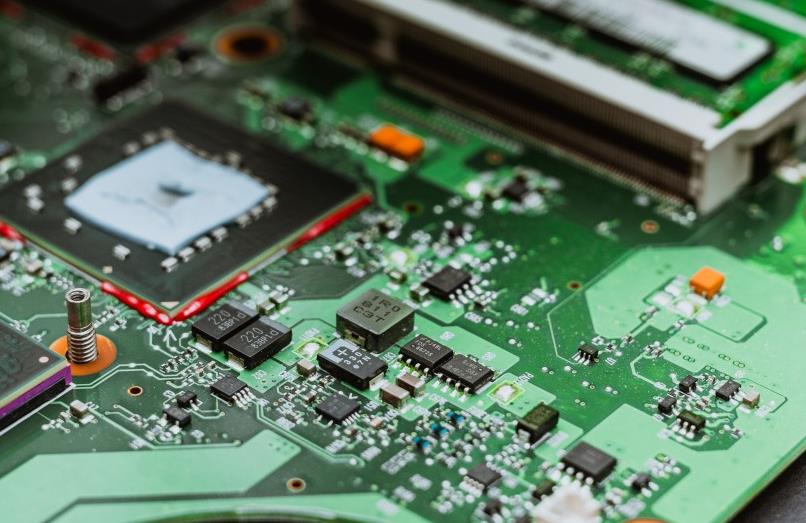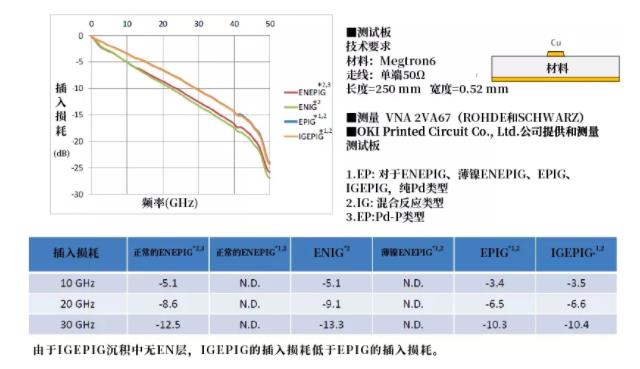With the growth of mobile phones, Internet access, and handheld devices, the amount of information transmitted in high-frequency circuit board has increased dramatically. To deal with the massive data in the electronic system, PCB transmission of high-speed radio frequency signal requirements are becoming higher and higher, and the transmission speed has been improving. In the higher GHz frequency range, how to reduce the rf signal loss (also known as insertion loss) becomes increasingly significant. Insertion loss is the loss of signal power caused by inserting a device into a transmission line or optical fiber, expressed in dB. Insertion loss will lead to signal rising edge degradation or a higher bit error rate.
All PCB materials suffer from conduction and dielectric RF signal loss. The conduction loss is resistive and is caused by the conductive copper layer used in the high-frequency circuit board. On the other hand, the dielectric loss is related to the substrate (insulating material) used in the PCB. This column will focus on resistive conduction losses caused by copper layers.
The study of transmission loss involves plotting the electrical behavior (scattering matrix) of a linear electrical network in dB under various steady-state stimuli of electrical signals and increasing signal frequency (GHz). Transmission loss, also known as insertion loss, is the additional loss caused by the introduction of the device under test (DUT) between the measured correlation layers. Additional losses may be due to inherent losses and/or mismatches of the devices under test. In the case of extra losses, the insertion loss is defined as positive. The negative value of the insertion loss in dB is defined as the insertion gain.

Skin effect
Unlike dc or AC currents that flow through the conductor, rf currents do not penetrate deep into the conductor and tend to flow along its surface. This is known as the skin effect. The signal loss in the conductive copper layer is directly related to the phenomenon of the "skin effect". Skin depth is the depth of the conductor used for RF current. Basically, as the high frequency increases, fewer conductors are used, as shown in Figure 1.
Two phenomena that directly affect insertion loss due to the "skin effect" are copper roughness (Figure 1) and the properties of the surface coatings used. Surface coatings containing electroless nickel on their surfaces, such as electroless nickel precipitation (ENIG) and electroless nickel palladium precipitation (ENEPIG), exhibit greater insertion losses compared to copper due to the resistance properties of electroless nickel. Newer coatings such as electroless palladium precipitation (EPIG) and electroless palladium precipitation (IGEPIG) are preferred processes for achieving minimum insertion loss in high-frequency applications.
Surface roughness of copper
In the multilayer structure, the surface of copper is coarsened to enhance the adhesion between conductor and medium. Coarsening is done by chemical or mechanical methods to create a fixed position for the resin. This is effective for non-RF current applications and also for RF signals that propagate at low frequencies. However, skin depth decreases as the frequency increases to 10 GHz or more. When the skin depth is equal to or less than the copper surface roughness (FIG. 1), the roughness will lead to an increase in wire resistivity and will affect conductor loss and phase Angle response of the circuit.

Figure 1: Skin Effect of Copper Conductor
As the high frequency of the signal increases, the electrical signal gets closer and closer to the surface of the copper conductor, thus increasing the resistance and transmission loss.
A circuit that uses copper with a rough surface will suffer more conductor losses than one that uses copper with a smoother surface. More specifically, the copper surface at the substrate - copper interface is a concern for surface roughness related to conductor loss. Recent developments in improving the adhesion of multilayer boards go beyond standard coarsening for black and brown oxide formation.
Today, most of the inner layers rely on chemical etching to slightly coarse the wiring for maximum bonding. However, coarsening is not a method to minimize conductor signal loss. The industry is choosing chemical adhesives to improve the adhesion of wires carrying high-frequency RF signals; It is also very effective on smooth copper surfaces.
One chemical bonding system currently available is a combination of tin deposition followed by treatment with a silane coupling agent. This processing is usually carried out in horizontal transport equipment and produces a good adhesion between the conductor and the medium. An article [1] reported, "Studies have shown that copper foil types with different roughness have a direct effect on the insertion loss of strip-line structures. Chemical suppliers are offering new treatments designed to minimize conductor insertion losses and surface roughness."
Surface roughness of copper
Handheld devices are a key driver for circuit designers to achieve miniaturization. For such applications, fine alignment and spacing are being normalized. In addition, the demand for lead bonding is focused on ni-gold (ENIG) and Ni-palladium (ENEPIG) coatings. When it comes to RF signal transmission above high frequency (10GHz), certain limitations need to be met. The electroless nickel coating is a part of the conductor surface. Compared with copper, there are transmission losses related to the skin effect of electroless nickel plating.
New surface coatings are available for high-frequency RF transmission. These coatings eliminate or reduce the use of EN. At present, the most common is electroless palladium precipitation gold (EPIG). I introduced the EPIG in my last column. The focus of this article is insertion loss.

Figure 2: Comparison of insertion loss of coatings on nickel containing, thin nickel and nickel free surfaces
Figure 2 includes the scattering parameter (S parameter) as the relationship between the signal frequency on the vertical axis and the horizontal axis. Under the S parameter, scattering refers to how current and voltage in a transmission line are affected when they encounter discontinuities caused by network insertion into the transmission line. A baseline is established and a new curve is measured by introducing the device under test. The difference is the transmission or insertion loss, measured in dB.
Figure 2 compares the insertion losses of ni (two ENEPIG and one ENIG ), little nickel (thin nickel ENEPIG), and no nickel (EPIG and IGEPIG) surface coatings. The thin nickel ENEPIG has only 4.0 μ Ins (0.1 μm) for electroless nickel plating. An IGEPIG is a variant of an EPIG. EPIC was deposited on the copper surface by a palladium leaching catalyst. IGEPIG uses a gold layer as a catalyst to deposit electroless palladium.
Different surface coatings were deposited on a single-ended 50 ω transmission route (250mm long, 0.52mm wide). The device for measuring insertion loss is VNA 2VA67 (Rhode&Schwartz). As shown in the figure and summarized in the table (FIG. 2), the insertion loss values of the coatings with low ni and noni are significantly increased compared to the coatings with the thickness (120 μin to 240 μin or 3 μm to 6 μm).
As the industry continues along with the trend of large-scale data transmission and miniaturization, the high-frequency circuit board PCB manufacturer Msignal transmission will continue to increase. For example, when RF frequencies above 10 GHz are involved, certain allowances must be reserved to minimize transmission losses due to copper roughness and surface coating type.